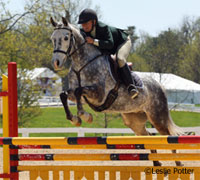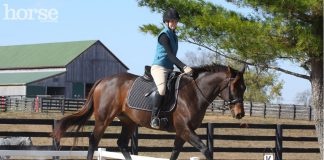 It’s easy to fall into the rut of riding through the same course every time you jump, especially if you don’t have the opportunity to work regularly with an instructor who can introduce you to new training techniques. However, this can cause your horse to grow bored, lose focus and potentially develop bad habits. Here are some fresh exercises to try at home. Be sure to set 18-inch cross-rails or 2-foot verticals (at least in the beginning), so the height will not present a challenge to your horse.
It’s easy to fall into the rut of riding through the same course every time you jump, especially if you don’t have the opportunity to work regularly with an instructor who can introduce you to new training techniques. However, this can cause your horse to grow bored, lose focus and potentially develop bad habits. Here are some fresh exercises to try at home. Be sure to set 18-inch cross-rails or 2-foot verticals (at least in the beginning), so the height will not present a challenge to your horse.
1) Transitions Between Fences
Start by calmly trotting your horse around a course of five or six fences, including one four- or five-stride combination (60 or 72 feet). Ask for a halt a few strides after the first fence. When your horse has completely stopped, pick up a trot again and ride toward the next fence. Break up sections of the course by asking for a few strides of walk between fences, if necessary.
Once your horse is relaxed and focused, begin the course again at a canter, coming down to a trot after each jump. Resume the canter a few strides before each fence. If this doesn’t stop him from rushing, come down to a walk for several strides before resuming the canter. You can also stay in a trot up to your fences if this is more helpful with correcting the rushing problem.
When you reach the combination, ask your horse to halt before proceeding to the second element. Variety will keep your horse on his toes and listening to you, which should be the objective every time you jump a course.
2) Disappearing Barrels
To give both you and your horse a new challenge, set up two barrels (or hay bales) next to each other, end to end between jump standards. Trot or canter over the middle of the jump a few times. Then remove one of the barrels or bales and move the standards in. This “skinny” fence may cause your horse to spook or stop, so keep your legs on firmly all the way up to the jump. If he’s still hesitant, tap him with the crop behind your leg. Once he pops over the jump, he should understand that it’s not big or scary and go over more willingly the next time. This exercise will get him thinking much more than when he jumps a wide, inviting fence. It requires a high degree of accuracy to go through the center of the standards.
TIP: If you’re looking for plastic barrels you can use for lightweight, convenient jumps, go to your local carwash. Barrels are often used to store soap and can be purchased for under $10. You can fill the bottoms of the barrels with sand to keep them from blowing around on windy days.
3) Jumping on a Circle
In addition to keeping your horse keen and attentive to these jumping challenges, he should remain as obedient and supple to your aids as he would be in his regular flatwork.
On a large circle (at least 20 meters in diameter), set up two or three equally spaced jumps. Starting at a trot, jump each fence straight down the middle, but keep your horse’s body bending along the arc of the circle between fences. Try it at a canter to increase the level of difficulty if needed.
4) Jumping at an Angle
In your efforts to revitalize your training regimen, don’t just re-invent the jumps: try a whole new approach. Eventers and show jumpers often need to jump fences at an angle to shave off time on course, but it’s a good exercise to get your horse thinking and listening no matter what type of showing you do.
Try a shallow angle first, approaching just off of the perpendicular line you would normally take to a fence. It will probably seem strange, and it may be harder to see your distance, but horses usually aren’t as affected by this difference as their riders. If your horse aces this exercise, you can kick it up a notch by approaching jumps at gradually steeper angles until your approach is nearly parallel to the fence. At this point, your horse may think you want him to pass the obstacle, so keep your aids firm to create a channel that will keep your horse on the track you’ve mapped out in your mind. You can also ride to a jump with a regular straight approach after the angle jump if it helps you focus on your path.
An easy exercise for setting up an angled approach to a fence is the figure-eight. Set a jump in the center of the ring, parallel to the long sides. Pick up a trot or canter in the corner and begin the figure-eight by crossing the diagonal and jumping the fence at approximately a 45 degree angle. Continue your figure-eight by approaching the fence again along the other diagonal. This will test your horse’s responsiveness in both directions.
5) Rollbacks
One of the greatest challenges on a jump course is the rollback, a maneuver that requires your horse to react quickly off your aids, turning 180 degrees or more after one fence to approach the next.
To begin, set up two fences at a 90 degree angle to each other. Jump the first fence straight on, and then immediately begin your turn to the second fence. Don’t yank your horse’s head around, which will only make him unbalanced on the turn. Instead, keep your inside leg at the girth, and move your outside leg back behind the girth, squeezing all the way through the turn to support your horse’s body and keep him on the smallest arc you can manage. Gently squeeze the inside rein and support your horse with a steady outside rein along his neck. Most importantly, keep your eyes up and look ahead to where you are going—this will communicate to your horse and your own body what you need to do to get there.
Practice the rollback at the trot first if your horse has trouble balancing on a difficult turn, and then progress to the canter when he’s ready.
With the help of these exercises, you can knock the rust off your regular riding and jumping routine. Instead of going on autopilot, your horse will listen to you throughout your schooling session.
Further Reading
Horse Jumping Tips
Four Fences Seven Ways
Holly Caccamise is an event rider and senior associate editor of Horse Illustrated.
This article originally appeared in the May 2009 issue of Horse Illustrated. Click here to subscribe.





